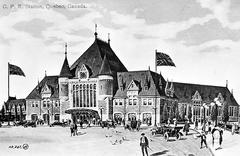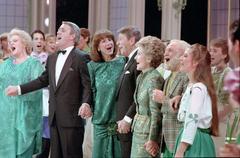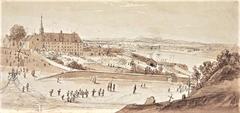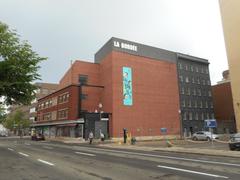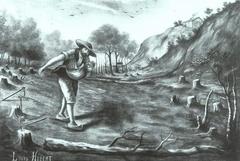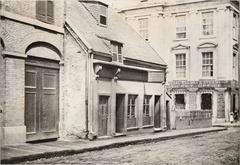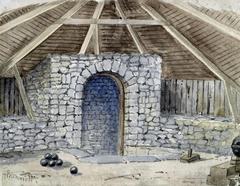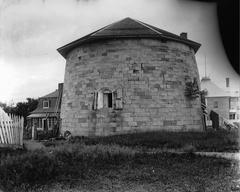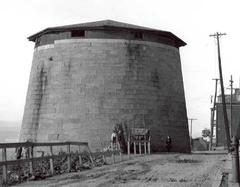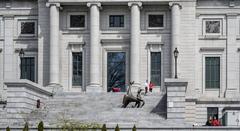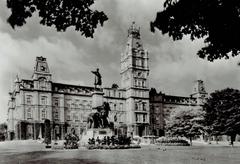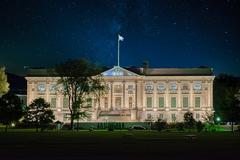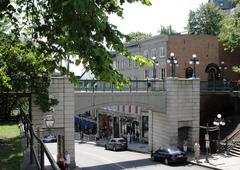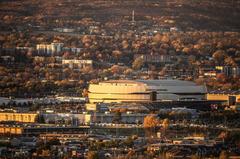
Boulevard Charest Quebec City: Visiting Hours, Tickets, and Historical Sites Guide
Date: 04/07/2025
Introduction
Boulevard Charest is a vibrant, historically rich thoroughfare in Quebec City, celebrated for connecting diverse neighborhoods and serving as a gateway to both contemporary culture and the city’s storied past. Named after Zéphirin Charest, a notable educational figure, the boulevard has evolved from two separate streets into a crucial east-west artery. It links the innovative Saint-Roch, the authentic Saint-Sauveur, and the green, family-oriented Limoilou districts, while providing easy access to Old Quebec’s UNESCO World Heritage sites and Parliament Hill. This guide delivers detailed visiting information, transportation tips, accessibility insights, and highlights of nearby attractions to ensure a rewarding visit to one of Quebec City’s most dynamic areas (Wikipedia; Quebec City Neighborhoods; Visit Quebec).
Table of Contents
- Introduction
- Origins and Historical Significance
- Urban Development and Neighborhoods
- Visiting Hours and Accessibility
- Getting Around: Transportation
- Attractions, Events, and Guided Tours
- Dining and Shopping Highlights
- Practical Visitor Tips
- Nearby Points of Interest
- Frequently Asked Questions (FAQ)
- Château Frontenac: A Nearby Must-Visit Icon
- Summary and Recommendations
- References
Origins and Historical Significance
Boulevard Charest derives its name from Zéphirin Charest (1813–1876), a parish priest key to the educational development of Saint-Roch. Established in 1928 by merging rue des Fossés and rue Charest, the boulevard was designed to meet the city’s growing transportation needs, soon becoming vital for both commerce and daily life (Wikipedia).
Urban Development and Key Neighborhoods
Saint-Roch: The Creative and Tech Hub
Saint-Roch, centered around Boulevard Charest Est, epitomizes urban renewal in Quebec City. Once industrial, it now thrives as a hotspot for technology companies, co-working spaces, arts venues, and nightlife. Rue Saint-Joseph, running parallel to Charest, is a commercial artery filled with cafés, independent boutiques, and microbreweries. The district’s multiculturalism is reflected in its diverse eateries and vibrant street art (Quebec City Neighborhoods; Brits in Canada).
Recommended visit duration: 2–3 hours.
Saint-Sauveur: Authentic Local Life
West of Saint-Roch, Saint-Sauveur retains its working-class roots and community spirit. This neighborhood features historic row houses, family-owned bakeries, local diners, and a festive atmosphere. It’s a place to experience daily Quebec life away from typical tourist paths (Quebec City Neighborhoods).
Recommended visit duration: 1–2 hours.
Limoilou: Family-Friendly and Green
Limoilou lies east of Saint-Roch, with Boulevard Charest bordering its southern edge. Known for its tree-lined streets, parks like Le Domaine de Maizerets, and a lively food scene, Limoilou draws families and young professionals. 3e Avenue, its main commercial street, is a hub for bistros and specialty shops (Brits in Canada).
Recommended visit duration: 2 hours.
Nouveau Saint-Roch: Urban Renewal
This area adjacent to Saint-Roch showcases affordable housing, new restaurants, and revitalized public spaces. Investments in infrastructure have produced a vibrant street life and improved accessibility (Brits in Canada).
Montcalm & Saint-Jean-Baptiste: Arts & Culture
Accessible from Boulevard Charest, these neighborhoods offer art galleries, theaters, and colorful streetscapes. Montcalm is home to the Musée national des beaux-arts du Québec, while Saint-Jean-Baptiste features bohemian charm and independent shops (Quebec City Neighborhoods).
Visiting Hours and Accessibility
Boulevard Charest is a public street open 24/7. Most shops, cafés, and attractions operate from 9 AM to 6 PM (some restaurants and venues stay open later). The boulevard is pedestrian-friendly, with wide sidewalks, bike lanes, and accessible crossings. Seasonal measures, like snow removal in winter, ensure year-round accessibility.
Getting Around: Transportation
- Public Transit: RTC bus lines (including routes 274, 280, 289, 3, 800, 801, and more) serve the boulevard, connecting to De La Couronne, Univ. Du Québec, Place-J.-Cartier, and Dorchester (Moovit Directions).
- Biking: Bike lanes and the àVélo bike-sharing system are available throughout central neighborhoods (Québec City Getting Around).
- Walking: The boulevard and nearby riverfront parks are ideal for pedestrians.
- Parking: Paid parking is available but limited during events or peak hours.
Attractions, Events, and Guided Tours
- Saint-Roch District: Explore Rue Saint-Joseph, Le Grand Marché de Québec (open Tues–Sun, 7 AM–6 PM), and Saint-Roch Church.
- Place Jacques-Cartier: Hosts open-air markets and art events from 10 AM–6 PM in warmer months.
- Parc Victoria: Offers sports and green spaces, open dawn to dusk.
- Photo Spots: Murals in Saint-Roch, Le Domaine de Maizerets in Limoilou, and historic streetscapes in Saint-Sauveur.
- Events: Seasonal festivals, public art installations, and holiday markets occur regularly (Afternoon Tea Reads).
- Guided Tours: Walking and culinary tours are available; booking in advance is recommended.
Dining and Shopping Highlights
- Microbreweries & Bars: Open daily, typically 11 AM–11 PM.
- Cafés and Bakeries: Many open from 7 AM for breakfast.
- International Cuisine: French, Asian fusion, and more—restaurants usually open 11:30 AM–10 PM (Tiny Footsteps Travel).
- Rue Saint-Joseph & Le Grand Marché: Known for boutiques, bookstores, and markets. Most shops open 10 AM–6 PM, with some open later (Québec City Shopping Guide; Local Food Tours Shopping Guide).
Practical Visitor Tips
- Best Times to Visit: Spring–fall for outdoor events and terraces; winter for festive markets.
- Transit & Bike-Sharing: Use RTC buses or àVélo for eco-friendly travel.
- Language: French is primary; English is widely spoken in tourist venues.
- Safety: The area is safe, but exercise standard precautions after dark.
- Accessibility: Most venues and sidewalks are accessible. Assistance is available at key locations.
Nearby Points of Interest
- Old Quebec (Vieux-Québec): UNESCO World Heritage site with historic landmarks, museums, and boutiques.
- Plains of Abraham: Historic park for walking and cultural events.
- Old Port and Bassin Louise: Offers riverside walks, boat tours, and a swimming area (Afternoon Tea Reads).
Frequently Asked Questions (FAQ)
Q: Are there entrance fees for Boulevard Charest?
A: No, it is a public street. Some events or guided tours may require tickets.
Q: What are typical visiting hours?
A: The boulevard is open at all hours. Shops and attractions generally operate 9 AM–6 PM.
Q: Is the area accessible for wheelchairs?
A: Yes, most sidewalks, crossings, and venues are accessible.
Q: Are bike rentals available?
A: Yes, through the àVélo bike-sharing program.
Q: Is the area safe?
A: Yes, but take usual precautions, especially at night.
Q: How do I reach Boulevard Charest from Old Quebec?
A: Take a 10–15 minute walk or a short bus ride via RTC transit lines.
Château Frontenac: A Nearby Must-Visit Icon
Introduction
The Château Frontenac is Quebec City’s most iconic landmark, famed for its dramatic architecture and storied history. Built in 1893 for the Canadian Pacific Railway, this hotel dominates Old Quebec’s skyline and is considered the world’s most photographed hotel (Fairmont Le Château Frontenac).
Visiting Information
- Public Areas & Restaurants: Open daily, 7 AM–11 PM.
- Guided Tours: Available May–October, 10 AM–4 PM. Tickets approx. CAD 15/adult, with discounts for children and seniors.
- Self-Guided Visits: Free access to the lobby and select public spaces.
- Accessibility: Fully accessible to visitors with reduced mobility.
- Nearby Attractions: Terrasse Dufferin, Old Quebec, Citadelle of Quebec.
For up-to-date information, visit the Fairmont Le Château Frontenac official site.
Summary and Recommendations
Boulevard Charest is a microcosm of Quebec City’s blend of historical legacy and modern urban vitality. Traversing neighborhoods like Saint-Roch, Saint-Sauveur, and Limoilou, it offers something for every traveler: from arts and innovation to authentic local cuisine and family-friendly parks. Its accessibility and proximity to major attractions—including Old Quebec and the Château Frontenac—make it essential to any Quebec City itinerary. For optimal exploration, make use of public transit, bike-sharing, and pedestrian pathways. Stay updated on events and tours by downloading the Audiala app or consulting official tourism resources (Brits in Canada; Québec City Shopping Guide; Afternoon Tea Reads).
References
- Wikipedia: Boulevard Charest
- Brits in Canada: Best Neighbourhoods in Quebec City
- Québec City Shopping Guide
- Fairmont Le Château Frontenac Official Site
- Quebec City Neighborhoods
- Visit Quebec: History and Heritage
- Afternoon Tea Reads: Things to Do in Quebec City
For up-to-date event listings, maps, and interactive guides, download the Audiala app or visit Quebec City’s official tourism websites.












